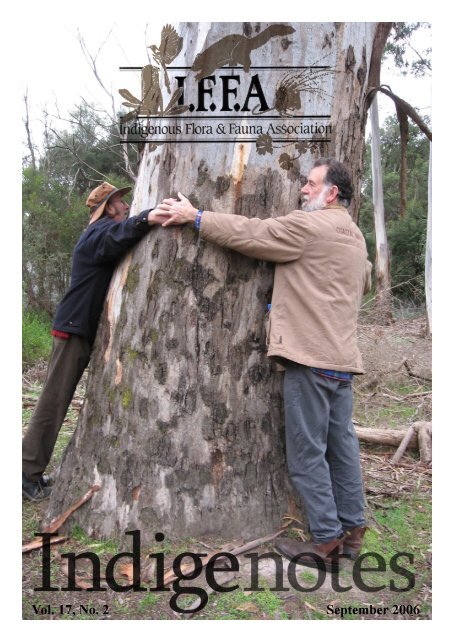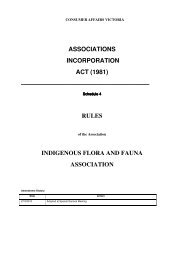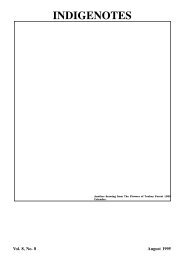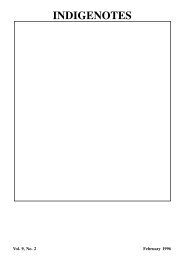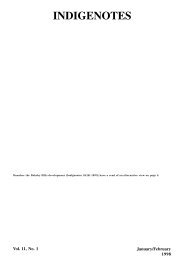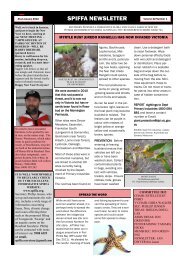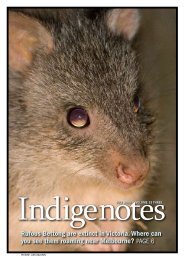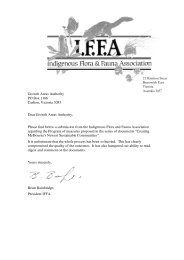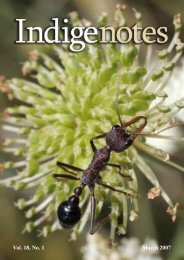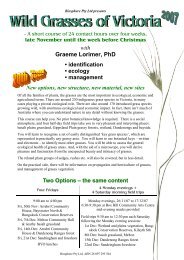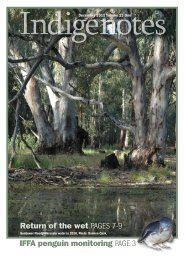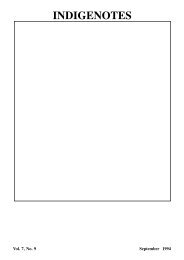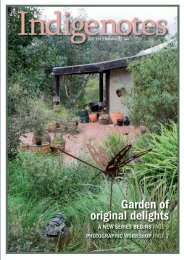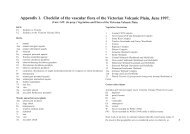Vol. 17, No. 2 September 2006 - Indigenous Flora and Fauna ...
Vol. 17, No. 2 September 2006 - Indigenous Flora and Fauna ...
Vol. 17, No. 2 September 2006 - Indigenous Flora and Fauna ...
You also want an ePaper? Increase the reach of your titles
YUMPU automatically turns print PDFs into web optimized ePapers that Google loves.
<strong>Vol</strong>. <strong>17</strong>, <strong>No</strong>. 2 <strong>September</strong> <strong>2006</strong>
Editorial<br />
The <strong>Indigenous</strong> <strong>Flora</strong> <strong>and</strong> <strong>Fauna</strong> Association was<br />
formed in 1986 by individuals who were concerned<br />
about raising the profile of native vegetation <strong>and</strong><br />
habitat, protecting it from removal <strong>and</strong> degradation,<br />
<strong>and</strong> starting to reverse the degradation by restoration<br />
<strong>and</strong> revegetation.<br />
It aimed to: “Promote<br />
awareness <strong>and</strong> conservation<br />
of indigenous<br />
flora <strong>and</strong> fauna (particularly<br />
in the Melbourne<br />
Region)”. IFFA<br />
brought together<br />
people already doing<br />
this work <strong>and</strong> others<br />
interested for support,<br />
exchange of ideas, <strong>and</strong><br />
to begin the task of<br />
convincing people that<br />
protecting <strong>and</strong> restoring<br />
remnant vegetation<br />
<strong>and</strong> planting indigenous<br />
plants should be<br />
basic management<br />
requirements.<br />
One of the first activities<br />
of the group was to<br />
publish a series of<br />
pamphlets under the<br />
banner “Melbourne’s<br />
<strong>Indigenous</strong> Gardens”.<br />
The pamphlets encouraged<br />
the conservation<br />
of remnant vegetation<br />
<strong>and</strong> the use of indigenous<br />
plants in rehabilitation<br />
<strong>and</strong> l<strong>and</strong>scaping,<br />
<strong>and</strong> gave local contact information for interested<br />
people who wanted to take it further.<br />
IFFA has seen many successes. Protection of remnant<br />
vegetation has become enshrined in law. The<br />
importance of managing environmental weeds has<br />
been recognised. Native vegetation management has<br />
become an industry, with expertise developing<br />
rapidly. Many local indigenous nurseries have been<br />
set up <strong>and</strong> promote the use of indigenous plants.<br />
Greening Australia has set up a training program. A<br />
journal (Ecological Management <strong>and</strong> Restoration) has<br />
been established to exchange information about<br />
technical matters.<br />
Quite a few of the 'old folk' of IFFA, as well as new<br />
members <strong>and</strong> interested people got together in June<br />
to celebrate 20 years of IFFA. We met at the Wildlife<br />
Reserves at La Trobe University, now known as the<br />
Melbourne Wildlife Reserve. Things had certainly<br />
changed, especially the<br />
vegetation. 20 years<br />
ago much of the<br />
campus reserve was<br />
little more than grazed<br />
paddocks. Some of us<br />
found it hard to recognise<br />
where we were,<br />
but there were a few<br />
l<strong>and</strong>marks (see front<br />
cover).<br />
Cover Photo<br />
Geoff Carr talked to us<br />
about the history of<br />
IFFA. R<strong>and</strong>all<br />
Robinson reminded us<br />
of a whole swag of<br />
IFFA's other achievements<br />
<strong>and</strong> the challenges<br />
ahead. After a<br />
barbeque lunch we<br />
were taken on a short<br />
tour of the reserve by<br />
one of the Rangers,<br />
Anthony Theunissen<br />
<strong>and</strong> finished up having<br />
a cuppa at the office<br />
where we were fascinated<br />
by the wireless<br />
network infrared<br />
cameras monitoring<br />
activity inside nesting<br />
boxes in the reserve.<br />
The Melbourne Wildife Reserve is well worth a visit.<br />
It's open 9-5 weekdays <strong>and</strong> sometimes on Sundays.<br />
The Keelbundoora <strong>Indigenous</strong> Nursery which is part<br />
of the reserves is open every Sunday.<br />
Photo from Jon Greening of<br />
the 20 year re-union at the<br />
Melbourne Wildlife Reserves<br />
at La Trobe University. It<br />
took 3 people to hug this fine<br />
old Red Gum.<br />
Page 2<br />
<strong>Indigenous</strong> <strong>Flora</strong> <strong>and</strong> <strong>Fauna</strong> Association Inc. (Incorporated Association <strong>No</strong> A0015723B)
From our Suburban Correspondent<br />
One of the things I like about planting indigenous<br />
plants is never having to say you’re sorry. <strong>No</strong> matter<br />
how scruffy it looks next to the neighbour’s weeds,<br />
you know it belongs right where you planted it.<br />
Unlike a glorious magnolia whose only value is<br />
superficial, a scrawny indigofera that’s growing so<br />
open you can hardly tell it’s there has an intrinsic<br />
value that goes beyond any frivolous opinion on its<br />
appearance. Yes, I am an indigenous gardener. I<br />
have truth on my side.<br />
So here I am, weeding my attempt at a microlaena<br />
lawn, knowing that there is only one true grass <strong>and</strong><br />
all the rest are evil.<br />
I start to become familiar with the evil grasses. There’s<br />
the one that I think is Poa annua <strong>and</strong> another that may<br />
or may not be squirrel grass. There’s the super fine one<br />
that comes up every spring, turning the muddy bald<br />
patch outside Arie’s bedroom door into two square<br />
metres of golf course before dying off in the summer,<br />
leaving us with a scale-model desert. There’s the one<br />
that looks like Microlaena on growth hormones. (Could<br />
it be Microlaena? Is that what Microlaena looks like<br />
when it’s not struggling to survive in a hyco tray that<br />
should have been watered days ago? What if it is<br />
Microlaena? That would save me a lot of weeding.<br />
What if it is <strong>and</strong> I think it’s not <strong>and</strong> I spend the remainder<br />
of my life pulling it out <strong>and</strong> then one of those VINC<br />
people come around <strong>and</strong> tell me what a fool I’ve been?<br />
Relax, Neil. If you pull it all out, they’ll never know.)<br />
Weeding. Weeding, weeding, weeding. I look at a<br />
clump of grass(es) <strong>and</strong> it appears to have some<br />
Microlaena-like features. There’s probably some<br />
Microlaena in there, but where do I start? I pull away<br />
something that looks wrong. It looks better. I remove<br />
another clump of something evil. And then<br />
another. And then there’s a moment when the gates<br />
of perception open in my aging brain <strong>and</strong> voila - it’s<br />
not just a clump of grass anymore. It’s a beautiful<br />
little clump of Microlaena.<br />
Indigenotes <strong>Vol</strong>ume <strong>17</strong>, Number 1, April <strong>2006</strong><br />
Don’t ask me what makes grass look like Microlaena.<br />
The answer probably involves a lot of words like<br />
lanceolate or bifurcated. All I know is that I’ve looked<br />
at 1300 Microlaena seedlings, pricking out the precious<br />
little bastards <strong>and</strong> sticking them in hyco trays.<br />
Never again. I’ve collected a bit of seed from the first<br />
round of plants, <strong>and</strong> I’m going to broadcast it this<br />
spring. Wish me luck.<br />
The first round of plants came from VINC, but also<br />
from seed that was given to me by a friend who lives<br />
about a kilometre away, next to Rosanna Parkl<strong>and</strong>s,<br />
whose garden is only nominally separated from the<br />
Parkl<strong>and</strong>s by a treated pine railing. One kilometre.<br />
How indigenous is that?<br />
Weeding, weeding. It’s a strange kind of meditative<br />
state, but I can’t let it become robotic, because if I do,<br />
I’ll just end up pulling things out because they’re<br />
green. And there’s a sort of zen in-the-moment<br />
thing. If I start to think about outcomes, about where<br />
this is all heading, about how much longer it’ll take or<br />
whether it’ll ever be done, I’ll go crazy. Because<br />
weeding is never done. Never. It has no past, no<br />
future. Weeding is now. And always will be.<br />
I st<strong>and</strong> up <strong>and</strong> stretch <strong>and</strong> groan <strong>and</strong> hobble about.<br />
My certainty about the one <strong>and</strong> only true grass is<br />
rattled a bit when I look at the Isolepsis that has<br />
escaped from the bog garden. It looks really good<br />
growing on the wrong side of the paving stones<br />
around the pond, forming a natural link between the<br />
lawn <strong>and</strong> the pond. Last summer I found out that<br />
you can mow Isolepis. I decided to try mowing the<br />
Microlaena to see what would happen <strong>and</strong> the Isolepis<br />
grew right back. Happy as Larry. The Microlaena has<br />
still not grown back. It just sits there, looking mown.<br />
Maybe it’s waiting for spring. Maybe it’s waiting for<br />
me to stop worrying.<br />
Page 3
The Beautiful Country:<br />
Extracts from Remarks on the Voyage to Western<br />
Port by William Hovell<br />
Jeff Yugo<br />
ugovic<br />
vic, , Biosis Resear<br />
esearch,<br />
During the short-lived Corinella settlement of 1826–<br />
1828, William Hovell explored parts of the Westernport<br />
region. Extracts from his journal of the expedition of 13<br />
to 23 January 1827 are presented here with comments.<br />
Hovell’s h<strong>and</strong>writing is not always easy to read so there<br />
may be a few transcription errors. He provides fascinating<br />
insights into the ‘beautiful’ country <strong>and</strong> its healthy<br />
<strong>and</strong> ‘no doubt happy’ people.<br />
A complete transcription of William Hovell’s journal<br />
would be worthwhile research.<br />
Sunday 14 January 1827, Plains Grassl<strong>and</strong>, around<br />
Yallock Creek:<br />
"I took two soldiers with me to trace up the course of the<br />
river, at half past we left <strong>and</strong> the distance of about one<br />
mile, I came to a fine level open country, very thinly<br />
covered with trees, soil of a good quality, <strong>and</strong> the grass<br />
long <strong>and</strong> fresh. . . the only objection to it is that I think it<br />
lies too flat to be perfectly dry in rainy seasons. The water<br />
is exceedingly good <strong>and</strong> the timber on the side of the creek<br />
or river is good also."<br />
Yallock Creek issued from the southern end of the<br />
Koo-Wee-Rup Swamp <strong>and</strong> was essentially the lower<br />
course of the Bunyip River which entered the swamp<br />
in the north-east (Rosengren 1984). Grassl<strong>and</strong> <strong>and</strong><br />
acacia open woodl<strong>and</strong> occurred extensively around<br />
the lower Yallock <strong>and</strong> separated the Koo-Wee-Rup<br />
Swamp from <strong>and</strong> Tobin Yallock Swamp to the south.<br />
The early survey plan of Smythe (1842) maps these<br />
relatively open areas between belts of Melaleuca<br />
scrub, <strong>and</strong> annotates them ‘black soil wooded with<br />
lightwood – good grass’. At that time Lightwood<br />
was Acacia melanoxylon, now Blackwood.<br />
Acacia open woodl<strong>and</strong> on alluvial plains is now extremely<br />
rare <strong>and</strong> yet was once a distinctive part of the<br />
l<strong>and</strong>scape of southern Victoria. Acacia melanoxylon was<br />
effectively the only tree species in this damp grassy<br />
ecosystem, probably due to its resilience to flood,<br />
drought <strong>and</strong> fire. Its strong suckering habit enabled it to<br />
survive fire. Occasional individuals would eventually<br />
reach tree size <strong>and</strong> thus avoid grass fires, forming an<br />
open woodl<strong>and</strong> on many sites. Open treeless plains<br />
also occurred in several areas around Western Port Bay.<br />
Plains Grassl<strong>and</strong> / Grassy Woodl<strong>and</strong>, west of Sawtell<br />
Inlet, Tooradin:<br />
"in less than one hour’s walk from the Entrance was<br />
enabled to see the l<strong>and</strong>, on the other side of the river, is<br />
clear <strong>and</strong> open…it has a very fine meadow <strong>and</strong> in other<br />
parts, park like appearance."<br />
Grassy woodl<strong>and</strong>s were relatively open under the<br />
Aboriginal fire regime <strong>and</strong> were spoken of in rapturous<br />
terms such as ‘beautiful’ <strong>and</strong> ‘delightful’ by William<br />
Hovell. Today many remnants of this endangered<br />
ecosystem have high woody cover due to lack of fire.<br />
Plains Grassl<strong>and</strong> / Plains Grassy Wetl<strong>and</strong>, Clyde-<br />
Tooradin Plain:<br />
"I came to another open space, quite clear of trees for<br />
several miles square, but so perfectly flat that the water<br />
appears to have no possibility of draining off, consequently<br />
after rain the ground must be some time before it can<br />
absorb the whole, but at this time we could not get a drop<br />
to moisten our lips, which would have been very acceptable<br />
from it being so very hot, <strong>and</strong> which we so much required,<br />
having come upon a Native path, which led in the direction<br />
I wanted to go, I kept upon it in hopes that it would lead to<br />
water"<br />
Since nearly all of the woodl<strong>and</strong> <strong>and</strong> scrub that defined<br />
the edge of this extensive treeless plain was cleared<br />
after European arrival, all living memory of this l<strong>and</strong><br />
system was lost. It was only with the recent discovery<br />
of Urquhart’s (1847) remarkably detailed survey plan<br />
that we have become aware of this once conspicuous<br />
feature.<br />
Rail line remnants of native vegetation on the natural<br />
surface of the plain are tussock grassl<strong>and</strong> but the plain is<br />
likely to have also supported grassy wetl<strong>and</strong>. This open<br />
plain was on the western edge of the impenetrable<br />
‘Great Swamp’ (Cook <strong>and</strong> Yugovic 2003).<br />
Tuesday 16 January: Beside an unidentified creek:<br />
"Passed many [native] huts on our way, on the sides of the<br />
creek, they had only left them a few days back, the grass all<br />
around has been burned lately."<br />
Page 4<br />
<strong>Indigenous</strong> <strong>Flora</strong> <strong>and</strong> <strong>Fauna</strong> Association Inc. (Incorporated Association <strong>No</strong> A0015723B)
Thursday 18 January: Grassy Woodl<strong>and</strong>, beside<br />
D<strong>and</strong>enong Creek:<br />
"We have been travelling over a very fine, I may say<br />
beautiful country, all hill <strong>and</strong> dale, <strong>and</strong> the creek running<br />
between, with a wide space of meadow l<strong>and</strong> on each side,<br />
the soil <strong>and</strong> grass on both very good, trees thin mostly<br />
Honey Suckel, Wattle & Gum, I have not seen a more<br />
interesting country anywhere, it is worth the attention of<br />
either farmer or grazier. . . passed a number of native huts,<br />
they are always to be found on the banks of rivers &<br />
creeks"<br />
Friday 19 January: Plains Grassy Woodl<strong>and</strong> (mature<br />
River Red Gums)<br />
"Some parts of the l<strong>and</strong> has a great deal of timber on it,<br />
<strong>and</strong> on others very little, but where that is the case it is<br />
very large, some would measure 40 feet in circumference,<br />
but they are always very short in the barrel."<br />
From the immense size <strong>and</strong> description of these trees,<br />
they must have been River Red Gum Eucalyptus<br />
camaldulensis. A few of these giants survive today.<br />
Encounter with Koories:<br />
Indigenotes <strong>Vol</strong>ume <strong>17</strong>, Number 1, April <strong>2006</strong><br />
"At 1 oclock 2 native men paid us a visit, they had tracked<br />
us for some distance, having heard us fire at some ducks,<br />
they left us for a short time, <strong>and</strong> took some tea which had<br />
been given them to show their friends, which were encamped<br />
at no great distance from us, but previously to them<br />
going I made them underst<strong>and</strong>, that if they brought the tin<br />
pot back I would give a tomahawk in lieu, in half an hour<br />
they returned bringing an old man with them, who from the<br />
great degree of familiarity used towards us, <strong>and</strong> his examining<br />
everything belonging to the party with a sort of desire, I<br />
strongly suspected him to be a rogue, <strong>and</strong> cautioned the<br />
men against him, I was not long before my suspicions were<br />
verified for having found where the hatchet was put, used by<br />
us, he contrived to conceal it under his cloak, <strong>and</strong> appeared<br />
carelessly lounging about, at the same time sideling off<br />
towards a thick scrub close by, on seeing that I enquired if<br />
the hatchet was safe, it was gone, <strong>and</strong> he was going too, but<br />
the sight of a musket pointed towards him brought him back<br />
quickly. . . knowing the way to treat them on those occasions,<br />
not coercively but by signs the very white people treat<br />
each other under such circumstances, afterwards we<br />
became good friends, <strong>and</strong> he with the others requested we<br />
would accompany them to their camp to get the tin pot, <strong>and</strong><br />
at 2 oclock set forward for that purpose, on arrival within a<br />
short distance of the camp, the women <strong>and</strong> children retreated,<br />
the men began to arm themselves with their spears<br />
<strong>and</strong> called out to those with us to keep the guns, of which<br />
they are in very great dread, further off, judging the occasion<br />
of the alarm I gave my piece to one of my party, all of<br />
whom I had decided to keep at a distance, <strong>and</strong> went to the<br />
camp alone, on seeing me unarmed they laid down their<br />
spears <strong>and</strong> became perfectly reconciled, I made them<br />
sensible where I had been & where I was going, gave each of<br />
them fishing hooks (which they knew the use of) <strong>and</strong> the<br />
tomahawk to the young man, who in return gave me the tin<br />
pot, <strong>and</strong> we set forward on our journey but the old man who<br />
had stolen the hatchet now made up for the breach of good<br />
faith, by accompanying us to a considerable distance (about<br />
a dozen followed) <strong>and</strong> put us upon a path which he gave me<br />
to underst<strong>and</strong> would take me to where the boat can come,<br />
this was the river I wanted [Sawtell Creek]. There were<br />
several old men among them, but one in particular which<br />
appeared the chief was the oldest, the hair on his head &<br />
also his beard, which was very long, was perfectly white, his<br />
legs <strong>and</strong> arms very small, but he appeared in good health<br />
<strong>and</strong> I should judge him to be about 70 years, they are all in<br />
what may be termed good case, <strong>and</strong> from the cause of them<br />
having several good kangaroo legs, no doubt live well, they<br />
appear very active, <strong>and</strong> what ever we may think to the<br />
contrary, I have no doubt happy."<br />
In this fascinating encounter, Hovell would have known<br />
that a violent confrontation so far from help could have<br />
been disastrous. He appears to have been reasonably<br />
diplomatic <strong>and</strong> was able to communicate with the<br />
Koories effectively although he was in fact assessing the<br />
suitability of their l<strong>and</strong> for future European colonisation.<br />
"Some of the men & boys had one of the front teeth<br />
knocked out, others again had not. The most of them had<br />
curly heads, but one or two, had lank, they had parts of<br />
several kangaroo, one or two tin pots, some pieces of iron<br />
made into tomahawks, <strong>and</strong> some pieces of millen cloth.<br />
They had got their huts on the top of a small hill & creek<br />
on the side, <strong>and</strong> at the commencement of a very beautiful<br />
country, we had three hours travelling on this delightful<br />
country. . . the grass is very fine, but so thick <strong>and</strong> long<br />
although young that there is not a spot of earth to be seen,<br />
<strong>and</strong> there is not more than 2 or 3 trees on an acre except<br />
on the tops of the ranges."<br />
Further reading:<br />
Cook D & Yugovic J (2003). Clyde-Tooradin Grassl<strong>and</strong> re-discovered. The Victorian<br />
Naturalist 120: 140–146.<br />
Hovell WH (1827). Remarks on the Voyage to Western Port. Manuscript (microfilm<br />
copy), State Library of Victoria.<br />
Rosengren N (1984). Sites of geological <strong>and</strong> geomorphological significance in the<br />
Westernport Bay catchment. Environmental Studies Series 401,<br />
Department of Conservation, Forests & L<strong>and</strong>s, Victoria.<br />
Smythe GD (1842). Survey of the eastern coast of Western Port. L<strong>and</strong> Victoria.<br />
Urquhart WS (1847). Continuation of the survey of the Toomuc Creek to the Great<br />
Swamp. Central Plan Office, L<strong>and</strong> Victoria.<br />
Yugovic J & Mitchell S (in press). The Koo-Wee-Rup Swamp <strong>and</strong> associated<br />
grassl<strong>and</strong>s: A retrospective. The Victorian Naturalist.<br />
Page 5
Waterbirds of the Coorong<br />
Robert Bender<br />
The Coorong is a long narrow estuarine channel,<br />
extending along the South Australian coast from the<br />
swamps north of Kingston to the Murray mouth,<br />
about 100 km further north. Younghusb<strong>and</strong> Peninsula,<br />
a long s<strong>and</strong> dune, is the only l<strong>and</strong> between the<br />
Coor-ong <strong>and</strong> the Southern Ocean. It has always been<br />
a salty environment <strong>and</strong> has attracted multitudes of<br />
sea birds <strong>and</strong> migratory wading birds each summer.<br />
Some of them migrate from Siberia, Japan <strong>and</strong> China,<br />
others move short distances to <strong>and</strong> from the grassl<strong>and</strong>s<br />
further east in South Australia. A bird count in 1965<br />
yielded a figure of 250,000 waders of many species.<br />
In recent years the count has been of around 20,000<br />
to 30,000 birds. The habitat has very clearly been<br />
degraded by a variety of factors.<br />
For the past decade David Paton, research fellow at<br />
Adelaide Uni. has been surveying birds in the Coorong,<br />
assessing abundance <strong>and</strong> diversity of species <strong>and</strong> the<br />
changing mix of birds. For the past few years he has<br />
had the help of Earthwatch teams <strong>and</strong> in January this<br />
year I joined one of them: 15 volunteers, mainly from<br />
SA, but several from Victoria, NSW, ACT <strong>and</strong> even<br />
UK, all keen to help gather data about the decline of<br />
waterbirds in this beautiful area.<br />
David set us to perform various tasks – walking the<br />
east <strong>and</strong> west shores counting waders feeding along<br />
the shore or in the waters just offshore, boating up<br />
the centre counting birds in the middle of the kilometre-wide<br />
estuary; using spotting telescopes to intensively<br />
observe behaviour of individual birds; mistnetting<br />
<strong>and</strong> b<strong>and</strong>ing forest birds along Younghusb<strong>and</strong><br />
Pen.; sampling aquatic plants to assess food abundance<br />
for the herbivorous birds, fish-trapping to<br />
assess food abundance for fishing birds.<br />
One sign of the changing environment this year was<br />
the abundance of brine shrimp, indicating increasing<br />
salinity of the estuarine waters, mainly due to the<br />
damming of the Murray, which has radically reduced<br />
flows down that stream, <strong>and</strong> led to partial, or some<br />
years complete, closure of the Murray mouth, reduced<br />
or absent tidal flows, <strong>and</strong> consequent changes<br />
in salinity, among other things.<br />
Brine shrimp dead on the Coorong shore<br />
Counting birds can be quite difficult – some flocks<br />
were huge, thous<strong>and</strong>s of birds in a small area, many<br />
of them liable to suddenly fly off nervously at our<br />
approach.<br />
S<strong>and</strong>pipers on the tidal flats<br />
On my first day of boating, we had to ab<strong>and</strong>on the<br />
boat several times <strong>and</strong> walk around isl<strong>and</strong>s as the<br />
water was so shallow.<br />
Walking the Coorong shore<br />
Page 6<br />
We found some large flocks of Pelicans, up to 250 in<br />
some gatherings. They were roosting around 40 km<br />
from their feeding sites, so much energy was used<br />
daily in flights to <strong>and</strong> from their food sources, which<br />
are apparently much depleted from their usual<br />
<strong>Indigenous</strong> <strong>Flora</strong> <strong>and</strong> <strong>Fauna</strong> Association Inc. (Incorporated Association <strong>No</strong> A0015723B)
summer geographical spread. The same applied to<br />
large flocks of terns of various species, especially<br />
Whiskered Terns, which we observed fishing in large<br />
flocks. Asessments of their time budgets to measure<br />
levels of food stress showed they were foraging a very<br />
large part of daylight hours, so were having a hard<br />
time finding enough food to feed their young.<br />
Mist-netting of woodl<strong>and</strong> birds produced a delightful<br />
diversity of species <strong>and</strong> good numbers of insectivores,<br />
seed-eaters, predators, <strong>and</strong> nectar-feeders.<br />
A fox on the shore<br />
Sharp-tailed S<strong>and</strong>pipers <strong>and</strong> Red-capped Plovers<br />
gathered in little flocks of nervous <strong>and</strong> frenetic birds,<br />
pecking eagerly for tiny invertebrates along the s<strong>and</strong><br />
spits. Reduced tidal flows have very much diminished<br />
the surface area wetted by tidal waters, so these<br />
s<strong>and</strong>y areas cannot support as many birds as formerly.<br />
Brown Thornbill<br />
Foxes are abundant along the Coorong, much of it<br />
adjacent to farml<strong>and</strong>. On one shoreline walk we<br />
spotted a very large dog-fox stalking a flock of S<strong>and</strong>pipers.<br />
The abundance of foxes has made it necessary<br />
for many breeding birds to restrict their egglaying<br />
to the isl<strong>and</strong>s in the middle of the Coorong,<br />
<strong>and</strong> even these are not safe when the water depth,<br />
always shallow anyway, is particularly low, as foxes<br />
will wade across to some isl<strong>and</strong>s.<br />
Malleefowl nest with interpretive sign<br />
After one morning of mist-netting, we visited the last<br />
known active malleefowl nest in the area. This species<br />
has experienced a long-term decline with the<br />
spread of farms, coastal towns <strong>and</strong> foxes.<br />
Indigenotes <strong>Vol</strong>ume <strong>17</strong>, Number 1, April <strong>2006</strong><br />
Page 7
Waterbirds of the Coorong (continued)<br />
Summer was in the middle of the breeding season for<br />
some migratory waders, including Red-necked<br />
Avocets <strong>and</strong> Fairy Terns. On one afternoon I was<br />
lucky enough to be selected for the boat crew to visit<br />
a nesting isl<strong>and</strong> to capture <strong>and</strong> mark Fairy Terns. The<br />
Avocets lay eggs directly on the mottled s<strong>and</strong>y rocks<br />
where their speckled surfaces are cryptic so avoiding<br />
stepping on any was a real challenge – we saw them<br />
seconds before putting a foot down<br />
continuity of ecosystems, destroying a large area of<br />
shrubl<strong>and</strong>, creating an arid gash ex-tending 3 km<br />
through the ancient dunes <strong>and</strong> altering the water<br />
flows on his own l<strong>and</strong> <strong>and</strong> in the Coorong into which<br />
the drain empties. Allegedly the massive earthmoving<br />
project breached several planning laws <strong>and</strong><br />
heritage approval procedures, but was retrospectively<br />
legitimised by the Liberal government.<br />
Avocet eggs on offshore isl<strong>and</strong><br />
The Coorong is an area in big trouble – its status as a<br />
major feeding <strong>and</strong> breeding site for migratory waders<br />
is under serious threat, the mix of species is changing<br />
in important ways – a very large number of B<strong>and</strong>ed<br />
Stilts had appeared this year, a species formerly rare<br />
in the area, responding to the changing salinity <strong>and</strong><br />
the appearance of the brine shrimp on which they<br />
feed. The major declines have been observed among<br />
Small Migratory Waders, whose food needs have<br />
been severely damaged by the reduced water flows<br />
through the semi-closed Murray mouth.<br />
Fairy Terns are in serious decline on the Coorong,<br />
down from over 1000 breeding pairs to under 300.<br />
We rascals ran around the rugged rocks capturing<br />
flutter-ing little chicks, which would suddenly disappear,<br />
as they sat down against the eroded <strong>and</strong> jagged<br />
limestone <strong>and</strong> were so cryptic they were hard to find.<br />
David’s daughters had made some wire traps to<br />
capture <strong>and</strong> mark the parents, to help assess how far<br />
they were flying to their feeding sites. We observed<br />
Silver Gulls, which have become very abundant along<br />
the estuary <strong>and</strong> are now a big problem for waders,<br />
trying to steal eggs or chicks <strong>and</strong> being mobbed by<br />
aggressively defensive parent birds.<br />
On our last day we were taken to an infamous site at<br />
which one of the neighbouring l<strong>and</strong>-owners had<br />
excavated a huge drain to remove water from the<br />
wetl<strong>and</strong>s on his heritage-listed prop-erty, severing the<br />
Solutions to the problems of the waders <strong>and</strong> other<br />
sea birds require a multi-pronged program of action<br />
– increasing environmental flows along the Murray-<br />
Darling system, bringing an end to l<strong>and</strong>-clearing<br />
inl<strong>and</strong> of the Coorong, which is destroying habitat of<br />
short-distance migratory birds, <strong>and</strong> enforcing heritage<br />
<strong>and</strong> planning laws to prevent such atrocities as<br />
the above drain from being constructed.<br />
Page 8<br />
<strong>Indigenous</strong> <strong>Flora</strong> <strong>and</strong> <strong>Fauna</strong> Association Inc. (Incorporated Association <strong>No</strong> A0015723B)
Snippets<br />
Scrofa Hawk Moth<br />
While monitoring significant species in March 2004 at<br />
Jukes Rd Grassl<strong>and</strong>, Fawkner, Brian Bainbridge found<br />
a most stunning Hawk Moth.<br />
It was large, having a wingspan of 6 cm or so. Its<br />
body was large, brown <strong>and</strong> cigar shaped. The wings<br />
were brown, with red underwings, which it showed<br />
when disturbed. He took photos <strong>and</strong> later checked<br />
references to identify the moth, which turned out to<br />
be Hippotion scrofa, Scrofa Hawk Moth.<br />
Just over a year later I was unloading weeds just<br />
removed from Jukes Rd Grassl<strong>and</strong>. Amongst the<br />
weeds I found a large, smooth skinned caterpillar. It<br />
was brown with two large eye-spots at the front of its<br />
abdomen <strong>and</strong> off-white dotted lines <strong>and</strong> dark oblong<br />
patched along its body. It tapered abruptly at both<br />
ends, <strong>and</strong> had a small 'tail'. A spectacular caterpillar!<br />
Have a look at http://www.usyd.edu.au/macleay/<br />
larvae/sphi/scrofa.html <strong>and</strong> you will see what I mean.<br />
The caterpillar feeds on a strange variety of (nonnative)<br />
plants including Mirror Bush, Busy Lizzy, <strong>and</strong><br />
Fuchsias. Considering the diet <strong>and</strong> plants found at the<br />
site, we guessed the caterpillar had been feeding on a<br />
native, Hairy Willow-herb, Epilobium hirtigerum. This is<br />
an often unloved <strong>and</strong> unlovely native that is frequently<br />
disregarded for its habitat potential in moist soils. It<br />
rarely needs encouragement <strong>and</strong> may need reducing,<br />
in the early stages of revegetation, to allow the more<br />
permanent, ‘desirable’ plants to establish. Perhaps<br />
revegetators could leave an out of the way corner for<br />
these plants to flourish - with, hopefully, H. scrofa too.<br />
The moth occurs all over Australia plus New Caledonia,<br />
the New Hebrides <strong>and</strong> <strong>No</strong>rfolk Isl<strong>and</strong> (or worldwide<br />
- references differ). It has been celebrated on<br />
postage stamps <strong>and</strong> as a Yowie (series 4)!<br />
- Wendy Moore<br />
<strong>No</strong>cturnal Visitor<br />
Recently I was devastated when my neighbour had<br />
most of his garden clear-felled. While few of the trees<br />
<strong>and</strong> shrubs were natives it was loss for local wildlife.<br />
One tree in particular, a Jacar<strong>and</strong>a, was a sad loss for<br />
me. Though not major habitat, I liked this tree. It<br />
grew in the narrow space between our houses,<br />
adjacent to my front door. While it had kept me busy<br />
every month or so, up on the roof removing its<br />
debris, which was VERY effective at blocking roof<br />
plumbing, I mourned its loss.<br />
A while after it went I noticed one positive outcome<br />
of the Jacar<strong>and</strong>as demise. Outside my front door is a<br />
portico with obscure glass in its top third. <strong>No</strong>w,<br />
without shading from the Jacar<strong>and</strong>a, light from<br />
yonder street light breaks through, forming a glowing<br />
orb on this glass.<br />
Every evening I delight to find a marbled gecko – I<br />
have a resident, breeding population of these <strong>and</strong><br />
Weasel Skinks, in my yard – on the glass, presumably<br />
hunting the moths attracted by the light.<br />
I never turn on the porch or outside light now, as it<br />
disturbs my little friend. <strong>No</strong>cturnal, human visitors<br />
just have to watch their step as they negotiate the<br />
junk on my path!!<br />
- Wendy Moore<br />
FUTURE GUARANTEED?<br />
VICTORIA'S THREATENED SPECIES<br />
2 nd <strong>No</strong>vember <strong>2006</strong><br />
A one-day conference presented by the Environment Defenders<br />
Office Victoria i<strong>and</strong> the Threatened Species Network<br />
It is almost 20 years since Victoria's <strong>Flora</strong> <strong>and</strong><br />
<strong>Fauna</strong> Guarantee Act 1988 was introduced. Is the Act<br />
working? Is it up to 'guaranteeing' species in the future?<br />
This is an opportunity to hear speakers <strong>and</strong> panelists with<br />
scientific <strong>and</strong> legal expertise discuss topics including:<br />
What to list <strong>and</strong> when? Are the categories <strong>and</strong> listing<br />
criteria under the FFG Act appropriate? Can they respond<br />
to threats such as climate change?<br />
The interaction of the FFG Act <strong>and</strong> planning<br />
schemes. What is the role of local government? How<br />
can we protect threatened species on private l<strong>and</strong>?<br />
Date: Thursday 2 nd <strong>No</strong>vember <strong>2006</strong>, 9-4pm<br />
Venue: Arrow on Swanston - 488 Swanston Street,<br />
Carlton VIC 3053<br />
Cost: $22 (Community Groups) / $66 (Professionals)<br />
More Information: call the EDO on (03) 9328 4811<br />
Scrofa Hawk Moth, Hippotion scrofa (Sphingidae)<br />
Indigenotes <strong>Vol</strong>ume <strong>17</strong>, Number 1, April <strong>2006</strong><br />
Page 9
A formal indigenous garden at Fawkner<br />
By Neil Huybregts <strong>and</strong> Brian Bainbridge<br />
Fawkner Community House is located in the centre<br />
of the C.B. Smith Reserve on Jukes Road in Fawkner,<br />
not far from Merri Creek. When the house opened in<br />
2001, the garden was in poor condition, lacked any<br />
areas for people to congregate <strong>and</strong> harboured environmental<br />
weeds like ivy <strong>and</strong> desert ash. A dense<br />
hedge hid the house from public view.<br />
Following a working bee during which the hedge was<br />
removed from the front garden, a few of us got<br />
interested in the idea of creating an indigenous<br />
garden at the House. The informal indigenous garden<br />
at the Fawkner Library was commonly seen as<br />
messy, brown <strong>and</strong> drab by the locals, so in 2002, a<br />
few of us decided it would be good to create a formal<br />
indigenous garden in an attempt to marry sustainable<br />
gardening practices with local sensibilities. The<br />
Fawkner <strong>Indigenous</strong> Garden Group was formed <strong>and</strong>,<br />
in early 2003, a Sustainable Morel<strong>and</strong> Environment<br />
Grant was obtained from the City of Morel<strong>and</strong> <strong>and</strong><br />
work began in earnest.<br />
including Italian, Greek, Arabic, Yugoslav, Dutch,<br />
German, Maltese, Polish <strong>and</strong> ‘Anglo’. Less physically<br />
able participants were included with tasks such as<br />
making the excellent lunches (feasts!). The physiotherapist<br />
from Fawkner Community Health Service<br />
came to teach muscle warming-up exercises <strong>and</strong> safe<br />
working techniques.<br />
The final working bee was held with the Fawkner<br />
Arabic Women’s Support Group who filled <strong>and</strong><br />
planted out large concrete planter boxes which had<br />
been donated by Council. John Vestjens, a member<br />
of the group <strong>and</strong> a cabinetmaker by trade, built some<br />
seating around the paved area.<br />
A number of community meetings were held to<br />
discuss the project <strong>and</strong> the form that the garden<br />
would take. Merri Creek Management Committee<br />
were approached to provide expertise in plant selection<br />
<strong>and</strong> garden design <strong>and</strong> Brian Bainbridge, a<br />
Fawkner resident who is expert in indigenous flora<br />
became involved. Brian led an initial workshop to<br />
explore what we would like from the garden <strong>and</strong> then<br />
developed draft plans which were further ‘workshopped’.<br />
Renovations to Community House delayed garden<br />
development but, in February 2004, the group finally<br />
got stuck into the real work.<br />
We were clever enough to realise we needed professional<br />
advice on the paving design <strong>and</strong> installation <strong>and</strong><br />
Damian Bateson, a l<strong>and</strong>scaper who was on the VINC<br />
Board of Directors, was commissioned to direct <strong>and</strong><br />
assist with the paving installation at working bees.<br />
Damian knew exactly how to do many things that we<br />
seemed unlikely to work out by ourselves. His expertise<br />
laying-out, levelling <strong>and</strong> laying the pavers <strong>and</strong><br />
working with a bunch of amateurs was invaluable.<br />
Seven working bees were held over several months.<br />
Up to 25 people were involved in each working bee –<br />
weeding, digging over, shaping <strong>and</strong> levelling, laying<br />
paving, planting <strong>and</strong> cooking community lunches for<br />
participants. Residents attended from cultural groups<br />
The garden is divided into four ‘rooms’ defined by<br />
clipped hedges of Rock Correa (Correa glabra) <strong>and</strong> Smallleaved<br />
Eutaxia (Eutaxia microphylla var. diffusa) (below<br />
the eaves) <strong>and</strong> lines of Spiny-headed Mat-rush (Lom<strong>and</strong>ra<br />
longifolia) <strong>and</strong> Black-anther flax lily (Dianella revoluta<br />
sensu lato). Sheets of Tufted Bluebell (Wahlenbergia<br />
communis) <strong>and</strong> Common Everlasting (Chrysocephalum<br />
apiculatum) <strong>and</strong> Berry Saltbush (Atriplex semibaccata,<br />
selected to underplant a mature small Eucalyptus<br />
leucoxylon cultivar) fill in the foreground <strong>and</strong> surround a<br />
large mosaic bird-bath made by the Fawkner Youth<br />
Group. A staggered row of Lightwoods (Acacia implexa)<br />
along the barbed-wire-topped cyclone wire front fence<br />
were selected for their light shade, rapid growth <strong>and</strong><br />
narrow, high canopy to reduce the visual impact of the<br />
fence while still keeping the house visible from the<br />
Page 10<br />
<strong>Indigenous</strong> <strong>Flora</strong> <strong>and</strong> <strong>Fauna</strong> Association Inc. (Incorporated Association <strong>No</strong> A0015723B)
Community House<br />
carpark. The planting boxes were planted out with a<br />
flowery mix of Cut-leaf Daisy Brachyscome multifida,<br />
Common Woodruff, Asperula conferta, Matted Flax-lily<br />
(Dianella amoena) <strong>and</strong> Clustered Everlasting (Chrysocephalum<br />
semipapposum).<br />
The garden was launched formally at the end of<br />
<strong>No</strong>vember 2004 by Kelvin Thomson, the local MHR<br />
<strong>and</strong> a founding member of a number of local environment<br />
groups.<br />
The garden is often commented on favourably by users<br />
of the House <strong>and</strong> the seating is frequently used. The<br />
Lightwoods have grown rapidly <strong>and</strong> will soon provide<br />
welcome shade on warmer days. Many people express<br />
surprise that the plants are all ‘local’ indigenous plants.<br />
Since the garden was completed, group members<br />
have worked to maintain the garden by weeding <strong>and</strong><br />
clearing wind-blown rubbish, rabbit-proofing with<br />
tree-guards <strong>and</strong> watering over the summer in order<br />
to assist the plant establishment. The rabbit-proofing<br />
required major effort, including two rounds of ferreting!<br />
The garden is in good nick, despite the rabbit<br />
attacks <strong>and</strong> the mysterious disappearance of the<br />
Berry Saltbush. Was it v<strong>and</strong>als or was it some wellmeaning<br />
House participant who thought it was a<br />
weed?<br />
The garden is a useful example of a ‘formal-indigenous’<br />
garden for others in the process of designing<br />
gardens. Anyone who is interested in the garden is<br />
welcome to have a look. The house is open most<br />
days, especially 10am-4pm Monday to Thursday. If<br />
you’d like to know more, contact details are below.<br />
<strong>No</strong>w for the side <strong>and</strong> the back<br />
The Fawkner <strong>Indigenous</strong> Garden Group has recently<br />
received another grant from Morel<strong>and</strong> City Council to<br />
develop the side <strong>and</strong> back yards. We are planning to<br />
create a garden that combines indigenous plants with<br />
plants taken from House participants’ cultures <strong>and</strong><br />
experiences. We hope to create a space that encourages<br />
a sharing of the stories that connect people to<br />
their environment, both past <strong>and</strong> present.<br />
The current design consists of a zig-zag path connecting<br />
the back <strong>and</strong> side. About a dozen garden beds<br />
will be defined by the path <strong>and</strong> by structural plantings<br />
of indigenous shrubs <strong>and</strong> trees. Two new outdoor<br />
meeting areas, including one that uses a large existing<br />
carport, will be created. Waist-high planter boxes<br />
will allow less mobile people to participate in planting<br />
<strong>and</strong> tending.<br />
A design process of workshops <strong>and</strong> talks will seek<br />
design suggestions, invite the house users to nominate<br />
plants, <strong>and</strong> assist people to propagate material<br />
for the garden. Efforts will be made to reconnect<br />
people <strong>and</strong> their ‘special’ plants. Help will be sought<br />
from other community gardens <strong>and</strong> from garden<br />
societies for species <strong>and</strong> varieties that may be difficult<br />
to source in Australia. This part of the project should<br />
generate ongoing opportunities to highlight biohygiene,<br />
including the role of the customs department<br />
<strong>and</strong> the threat of environmental weeds. <strong>Indigenous</strong><br />
plants <strong>and</strong> their various human <strong>and</strong> wildlife<br />
associations with grow alongside the exotic plants in<br />
an effort to ensure a truly inclusive <strong>and</strong> fertile space<br />
for sharing the stories that have a role in connecting<br />
us to our wider environment <strong>and</strong> community.<br />
The garden is also envisaged as the setting for artwork<br />
rich in association created by <strong>and</strong> for house<br />
users. Herbs <strong>and</strong> plant materials from the established<br />
garden will be available for house cooking <strong>and</strong><br />
craft programs.<br />
We are keen to involve as many people as we can in<br />
developing the side <strong>and</strong> back gardens. If you’re interested,<br />
feel free to get in touch with either of us or the House.<br />
Neil Huybregts neilhuy@alphalink.com.au<br />
Brian Bainbridge brian@mcmc.org.au<br />
Fawkner Community House can be contacted on<br />
(03) 9432 7005.<br />
Indigenotes <strong>Vol</strong>ume <strong>17</strong>, Number 1, April <strong>2006</strong><br />
Page 11
INDIGENOUS GARDENS<br />
OPEN DAY<br />
21 October <strong>2006</strong><br />
The Southern Peninsula <strong>Indigenous</strong> <strong>Flora</strong> <strong>and</strong> <strong>Fauna</strong><br />
Association (SPIFFA), Mornington Peninsula Round<br />
Table (MP&WP Biosphere) <strong>and</strong> Trust for Nature have<br />
organised a tour of local indigenous gardens on the<br />
Peninsula. Come <strong>and</strong> see the array of beautiful local<br />
plants that can be used to create a stunning <strong>and</strong><br />
drought-tolerant indigenous garden.<br />
There are a range of properties – from Boogoolum at<br />
Main Ridge, to smaller blocks in Somers, Rye, Rosebud<br />
<strong>and</strong> McCrae – to look at. Properties in Red Hill,<br />
Flinders <strong>and</strong> Tuerong will also be on display.<br />
The self-drive tour will begin at 10.30am on Saturday<br />
21 October, from either Seawinds Park at Main Ridge<br />
or Boneo Primary School off Limestone Rd, where<br />
participants will receive a map of the gardens on<br />
display for the day. People can then choose which of<br />
the properties they wish to visit. Car-pooling for the<br />
event is recommended, <strong>and</strong> each venue is child friendly.<br />
Gold coin donation (market day parking fees apply at<br />
Boneo Primary - follow the signs to the wetl<strong>and</strong>s).<br />
Some venues will provide light refreshments.<br />
For more information on gardens, contact Gidja<br />
Walker on 0418 416 182, Carri on 5983 2072 or<br />
Virginia 5989 0223<br />
Membership<br />
IFFA membership costs<br />
$40 for non-profit organizations,<br />
$50 for corporations,<br />
$25 for individuals <strong>and</strong> families,<br />
or $20 concession.<br />
Membership includes<br />
4 issues of Indigenotes per year, enhanced<br />
access to IFFA's website at iffa.org.au<br />
<strong>and</strong> discount subscription to<br />
Ecological Management & Restoration Journal<br />
Members should check the mailing label to<br />
ascertain the status of their membership. If an<br />
invoice is required, please send a purchase<br />
order requesting an invoice.<br />
Membership applications <strong>and</strong> renewals should be<br />
sent to the membership secretary.<br />
CONTENTS<br />
Editorial: 20 years of IFFA 2<br />
Letter from the Suburbs 3<br />
The Beautiful Country - Jeff Yugovic 4<br />
Waterbirds of the Coorong - Robert Bender 6<br />
Snippets: Scrofa Hawk Moth, Marbled Gecko 9<br />
A formal indigenous garden at Fawkner Community<br />
House - Neil Huybregts & Brian Bainbridge 10<br />
Office Bearers:<br />
President: R<strong>and</strong>all Robinson, P.O. Box 122,<br />
Hurstbridge 3099. Email: president@iffa.org.au<br />
Vice-President: Ken Duxbury, email:<br />
vicepres@iffa.org.au, phone 9859 5192.<br />
Secretary: Michele Arundell (03) 97612787(ah)<br />
email: secretary@iffa.org.au<br />
Membership Secretary: Dimi Bouzalas<br />
(03) 93860264. 21 Harrison Street East Brunswick<br />
Vic 3057. email: membership@iffa.org.au<br />
Treasurer: Caroline Dunn, email: treasurer@iffa.org.au<br />
Committee members: Liz Henry, 9890 4542 (h), Jon<br />
Green 9529 2523 email: jonni5_is_alive@yahoo.com<br />
Editor: Tony Faithfull, (03) 9386 0264 (ah). 21<br />
Harrison St East Brunswick 3057. editor@iffa.org.au<br />
Webmaster: Peter Neish, web@iffa.org.au<br />
Website: www.iffa.org.au<br />
Contributions to Indigenotes should be sent to the<br />
editor — the deadline for the next issue is 30 October<br />
<strong>2006</strong>. Contributions must be in electronic form,<br />
either on PC formatted floppy disk or CD or can be<br />
sent to the editor by email.<br />
The views expressed in Indigenotes are not necessarily those of the<br />
<strong>Indigenous</strong> <strong>Flora</strong> <strong>and</strong> <strong>Fauna</strong> Association.<br />
Ecological Management <strong>and</strong><br />
Restoration Journal<br />
The leading Australian journal for those interested<br />
in the science behind restoration <strong>and</strong> management.<br />
Subscribe to EMR for 2007 at the special IFFA<br />
membership rate of s $59.40.<br />
See your Indigenotes wrapper for subscription<br />
details.<br />
Page 12<br />
<strong>Indigenous</strong> <strong>Flora</strong> <strong>and</strong> <strong>Fauna</strong> Association Inc. (Incorporated Association <strong>No</strong> A0015723B)


